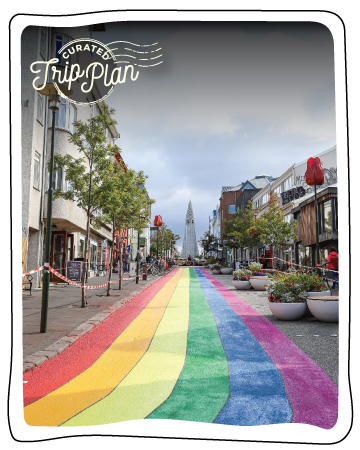Editor’s Note: We urge you to check local government restrictions, rules, and safety measures related to COVID-19 and take personal comfort levels and health conditions into consideration before you travel.
In contrast to its long dark winters, summers are mild and daylight stretches all the way to midnight in Iceland – the ‘land of the midnight sun’. And although you won’t be able to watch the Northern Lights in the summer, you will be able to enjoy the wildflower and moss covered valleys, and see and do things that are accessible, only when the heavy veil of winter lifts from this region. Here’s a list of the things you can experience in and around the Icelandic capital city of Reykjavik.
Watch whales and puffins
Summer in Iceland brings calm winds, few storms, and clear skies. Your chance of spotting cetaceans in the Arctic seas are much higher in the warmer season. It is also less likely that your whale-watching tours will be canceled from June to August. Thanks to the shallow water rich in nutrients the Icelandic seas are perfect for whales to feed through the year. There are many different species of whales that have made Iceland their homes – Humpback whales, Orca whales, Fin whales and the occasional Blue whales. The Minke whales are playful and in large numbers, along with the quick and quirky white-beaked dolphins. These waters even harbour porpoises!
In Reykjavik, some companies (such as Reykjavik Sightseeing, Arctic Sea Tours, Special Tours and Reykjavik Sailors) offer tours departing from the harbour to take you to a large bay called Faxaflói right between the Reykjanes Peninsula and the Snæfellsnes Peninsula. In case you don’t spot a whale, don’t fret; most companies offer the “Whale Guarantee”- if you don’t spot any whales on the tour, you get to go on another ride for free! These boat tours on an average cost ISK 11,000 (71 Euro).
Puffins only colonise Iceland in the warmer months (May-August). The Atlantic Puffin is both captivating and peculiar. There are many reasons why locals, artists and travellers alike are seduced by these bright-billed seabirds. All is calm while they are nesting but in flight, they seem manic, because of their small wings! Fun fact: Puffin wings can beat up to 440 times per minute. The Atlantic Puffin travels to land in the summer to nest during the warmer months.
There are many ways of going Puffin watching – you can rent a car and watch them on land or choose the more convenient and effective option, which is to go on a boat tour to watch them. Several of these tours start from Reykjavik (such as those offered by Arctic Adventures, Reykjavik Sailors and Mr. Puffin). These tours cost around ISK 6000 (40 Euro).
Unravelog Tip: You can cover both whale and puffin watching on the same tour, like in the one offered by Guide to Iceland.

Swim in a warm lagoon
The Nauthólsvik Geothermal Beach has been referred to as the best place to spend the summer in Reykjavik, and for good reason. The beach, with its golden yellow sands glistening in the sunlight, offers a refreshing area to sunbathe and swim around. This beach is unique because it’s a man-made lagoon that is filled with hot water, making it truly one-of-a-kind! The lagoon is warmed up to a comfortable 15-19℃ during summer. Other than the lagoon, you can also access their sauna and pools, which are perfect to visit if you have children. And oh, admission to the beach is free (including the pools, sauna, changing rooms and showers) during summers!
The City of Reykjavik runs the service centre, which offers towels and swim-suit rentals and operates Strandkaffi, where guests can purchase ice cream, hot dogs, fizzy drinks and other refreshments. After enjoying a day at the beach, you can check out the modern Nordic cuisine of a nearby environmentally-certified restaurant, Nauthóll, or grab a delicious gelato at Perlan.
Kolaportið market, a collector’s dream
The Reykjavik Flea Market, called Kolaportið, is a weekend market located in the old harbour area. The first thing that greets you in Kolaportið is the smell (which may initially mess with your senses), which is a mix of fermented shark, dried fish, old books and ice cream. Once you get used to the smell, you can get on and enjoy the various things you can see and do at the market. The market is a collector’s dream, with amazing second-hand clothes, old books, records, jewellery, artwork and other vintage tidbits. Haggling is widely popular in Kolaportið. You can also find amazing food – liquorice, bread, dried fish and fermented shark and other foods that are popular in the area.
Unravelog tip: Take cash when you visit the market, as very few shops accept cards. Cash in hand also means that you have more bargaining power! There are ATMs located at the entrance of the market.
Swim 3000 ft. above sea level
If you fancy a hike, you’re in luck. Hiking is a cherished activity in the Icelandic summer. Landmannalaugar, or the ‘People’s Pools’, is a vast area of stunning and unique beauty in the heart of Iceland’s Southern Highlands. The dazzling and many-hued mountains of the Fjallabak Nature Reserve, make it a popular (and ethereal) place for hiking – either over one day or several. And while you’re at it, you can bathe and relax in the natural and soothing hot springs, while soaking in the gorgeous mountain panoramas. It is roughly 3 hours from Reykjavik by car (or you can take a bus to Landmannalaugar with Arctic Adventures).
Brennisteinsalda and Bláhnjúkur are the most well-known mountains in the area. Lake Frostaðavatn and Ljótpollur (“Ugly Puddle”) are other fascinating stops to add to your list. Choose the Brennisteinsalda Hike or the Blahnukur Hike for the perfect day-hike.
Unravelog tip: If you have 4 days to spare, get on one of the best hiking trails in the world – the 55-mile Laugavegur Trail. Opt for guided treks if you aren’t a seasoned trekker.
Get to the top at Hallgrimskirkja
Visible from every corner of the smoky bay, the towering Hallgrimskirkja is hard to miss. It stands at 74.5 metres in height, and is the tallest church in Iceland. Located in the heart of Reykjavik, the Lutheran church was named after the 17th-century Icelandic poet and clergyman Hallgrímur Pétursson. Guðjón Samúelsson, one of Iceland’s most renowned architects, sought inspiration for his design of the church from elements of Icelandic nature. These include glaciers, mountains and lava formations. The design bears resemblance to Thor’s hammer, with its handle facing upwards. The large pipe organ inside Hallgrímskirkja, consists of over 5000 pipes!
To capture some panoramic photos of Reykjavik, take the elevator to the top of the Hallgrímskirkja church tower. In the summer, the tower is open till 8:30 pm, and is the perfect place to bask in the soft light of golden hour.
Unravelog tip: Impress the locals with your knowledge of the Icelandic language – remember that double ‘L’s are pronounced in Icelandic as ‘th’, which means that the pronunciation of Hallgrímskirkja is (roughly) ‘Hath-creams-keerk-yuh’.

Snorkel between continents at Silfra Fissures
Welcome to the only place in the world where you can dive or snorkel in a crack between two tectonic plates, filled with pure glacial water! And if that isn’t exciting enough, the waters are crystal clear and allow for a 100-120 meter visibility. An hour’s drive from Reykjavik, Silfra is a fissure between the North American and Eurasian tectonic plates in Thingvellir National Park. The rift was formed in 1789 by earthquakes accompanying the divergent movement of the two tectonic plates. The diving and snorkelling site at Silfra is right where the two continents meet and drift apart about 2 cm per year. On your explorations you can view different varieties of algae, bright green ‘troll hair’ together with the clear blue waters, form a unique and unforgettable colour scape.
Snorkelling at Silfra was rated as one of the top ten activities to do in the world in 2019! If you would like to snorkel in the Silfra ravines check out DIVE.IS, Troll Expeditions or Guide to Iceland.
Unravelog tip: Since Snorkelling at the Silfra fissure is widely popular, set off as early in the morning as possible, so you don’t have to snorkel underwater and just end up watching other people.
Katla Ice Caves
Most ice caves that one can visit in Iceland are seasonal and only form during the winters. However, the Katla Ice Caves in the Mýrdalsjökull glacier is open all year round! There are pickups from Reykjavik, so this makes it easy to visit. Situated right next to the Katla Volcano, you can experience the polar extremes of the Icelandic natural wonders here.
Locals fear the proximity of the Katla volcano, due to the countless accounts and stories on the eruption of 1918. However, as you ride towards the glacier in a super-jeep (the most common transport to the ice caves) – the beauty of the pitch-black lava sand juxtaposed with the green mountains, forms an irresistible sight.
Formed in the glacier tongues, water from the melting glacier carves an opening in the ice. You can go into these caves and walk through the black and blue ice tunnel with beautiful shiny ice formations. Adventures and Reykjavik Excursions offer tours with pickups from Reykjavik to the Katla Ice caves.
Unravelog tip: Wear clothing in yellow on your trip to the ice caves. It will lend a pop of bright colour to all your photos, against the dark background!

If you have more time in hand and want to explore this delightful city further, check out our detailed itinerary that will help you to unravel Reykjavik in 3 days.






